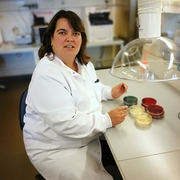- Level Professional
- Duration 9 hours
- Course by Technical University of Denmark (DTU)
-
Offered by

About
The course will cover the topics related to antimicrobial resistance with basic definitions and overview on antimicrobials their use and the emergence and spread of resistance. The course will guide you through the concepts and the importance of resistance spread and dissemination and how that happens. It will show you how bacteria become resistant and which mechanisms they might use for this. And as part of the course you will also receive some training in methods for antimicrobial susceptibility testing (AST) and detection of specific resistance in the microbiological laboratories with the basic methods available and with focus on the obtention of good quality results which can be interpreted and used for different purposes. Additionally, it will show you how to use genomic analysis tools to analyze whole genome sequencing data to detect resistance genes (and or other genes of interest) in a simple and easy way using online tools freely available. In the new new version an additional module including detection of specific resistance mechanisms was added. After this course you should be able to: 1. Describe the most important families of antimicrobials and mode of action 2. Understand the basic concepts of antimicrobial resistance from several perspectives (clinical, research and microbiological) 3. Enumerate and describe how bacteria can become resistant and the mechanisms that may be involved in that process 4. Describe how antimicrobial resistance emerges and spreads around the world including concepts of antimicrobial resistance transfer, selection and dissemination 5. Enumerate the methods used for antimicrobial susceptibility testing (AST) 6. Compare dilution and diffusion methods and know the basic techniques of agar disk diffusion, broth dilution and agar dilution methods 7. Have detailed theoretical knowledge on how to perform the main methods in a laboratory 8. Know the basic concepts about analysis and interpretation of results of AST, including different breakpoints, cut-off setting and their applications. 9. Understand the importance and related concepts related to quality management and quality assurance method standardization, applied to AST 10. Relate the information obtained in this course with real cases of resistant bacteria spreading in patients, the community, animals or the environment 11. Relate the phenotypical results with results from genotyping using molecular techniques for detection of resistance mechanisms 12. Understand the concept and be able to apply genomic analysis tools used to detect resistance genes and other relevant genes from Whole Genome Sequencing (WGS) data (with demonstration of selected online tools) Disclaimer: Please note that the guidelines and methods referred or links included in these materials are updated when the videos lectures are produced and before the course is released, however these might become outdated with time.Modules
Welcome and basic information
1
Videos
- Welcome to this course
1
Readings
- NOTE: course update announcement
Lectures
1
Assignment
- Q1- Quizz Lectures 1-2 (antimicrobials)
2
Videos
- Lecture 1- Antimicrobials and antimicrobial classification
- Lecture 2- Antimicrobials and antimicrobial action
Antimicrobials and resistance
1
Assignment
- Q2- Quizz Lectures 3-6 (antimicrobial resistance)
4
Videos
- Lecture 3- Antimicrobials and resistance
- Lecture 4- Antimicrobials and resistance- causes and mechanisms
- Lecture 5- Antimicrobial resistance- emergence and dissemination
- Lecture 6- Antimicrobials and resistance - selection
Antimicrobial susceptibility testing
2
Assignment
- Q3- Quizz Lectures 7-11 (AST)
- Q4- Quizz Lecture 12 (interpretation AST)
9
Videos
- Lecture 7- Antimicrobial susceptibility testing
- Lecture 8- Antimicrobial susceptibility testing- methods
- Video 2_How to use gradient strips
- Lecture 9- Antimicrobial susceptibility testing- disk diffusion
- Performing disk diffusion
- Lecture 10- Antimicrobial susceptibility testing- agar dilution method
- Lecture 10- Antimicrobial susceptibility testing- agar dilution scheme
- Lecture 11- Antimicrobial susceptibility testing- broth dilution
- Lecture 11- Antimicrobial susceptibility testing- How to do broth micro dilution
Genomic analysis tools
1
Assignment
- Q6- Quizz Lectures 15-16 (WGS tools)
2
Videos
- Lecture 16- Alternative tools for AMR determination- ResFinder tool principles and applications
- Lecture 15- My Database Finder (MyDbFinder) tool principles and applications
Quality Assurance
1
Assignment
- Q5- Quizz Lectures 13-14 (Quality assurance)
2
Videos
- Lecture 23- Quality management in Antimicrobial susceptibility testing
- Lecture 24- Quality assurance when doing antimicrobial susceptibility testing
Specific resistance mechanisms
1
Assignment
- Quiz 7
5
Videos
- Beta-lactam resistance in Escherichia coli: ESBL and AmpC
- Beta-lactam resistance in Escherichia coli: Carbapenemases
- Beta-lactam resistance in staphylococcus aureus: MRSA
- Background, detection and characterization of colistin resistance
- Lecture 11 -Background, detection and characterization of quinolone resistance
Examples of antimicrobial resistance surveillance systems
5
Videos
- Surveillance- an important action area to combat antimicrobial resistance
- DANMAP: Danish Integrated Antimicrobial Monitoring and Research Programme
- The InFARM IT platform and system
- GLASS: Global Antimicrobial Resistance and Use Surveillance System
- WHO Medically Important Antimicrobial list
Closing Remarks
1
Videos
- Closing remarks to course completion
Auto Summary
Discover the intricacies of antimicrobial resistance in this professional-level course designed for Science & Engineering enthusiasts. Led by Coursera, it delves into the emergence, spread, and mechanisms of bacterial resistance, alongside methods for antimicrobial susceptibility testing (AST). Over 540 minutes, learners will master genomic analysis tools and real-world applications, with a focus on quality results. Ideal for professionals in clinical, research, and microbiological fields. Available through a Starter subscription.

Lina Cavaco

Pimlapas Leekitcharoenphon

Rene S. Hendriksen


